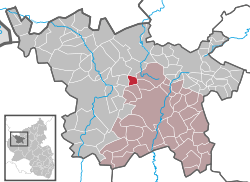Betteldorf
Betteldorf is an Ortsgemeinde – a municipality belonging to a Verbandsgemeinde, a kind of collective municipality – in the Vulkaneifel district in Rhineland-Palatinate, Germany. It belongs to the Verbandsgemeinde of Daun, whose seat is in the like-named town.
Betteldorf | |
|---|---|
 Coat of arms | |
Location of Betteldorf within Vulkaneifel district  | |
 Betteldorf  Betteldorf | |
| Coordinates: 50°15′08″N 6°45′21″E | |
| Country | Germany |
| State | Rhineland-Palatinate |
| District | Vulkaneifel |
| Municipal assoc. | Daun |
| Government | |
| • Mayor | Werner Michels |
| Area | |
| • Total | 3.31 km2 (1.28 sq mi) |
| Elevation | 540 m (1,770 ft) |
| Population (2018-12-31)[1] | |
| • Total | 254 |
| • Density | 77/km2 (200/sq mi) |
| Time zone | CET/CEST (UTC+1/+2) |
| Postal codes | 54570 |
| Dialling codes | 06595 |
| Vehicle registration | DAU |
| Website | www.betteldorf.de |
Geography
Location
The municipality lies in the High Eifel at the foot of the Döhmberg, some 11 km northwest of the district seat of Daun. To the south, Bundesstraße 410 runs by the village.
History
Betteldorf’s name goes back to a Roman whose name was Betilo, and who ran a way station in what is now the municipal area where horses were changed on the Meuse-Moselle Roman road.
Politics
Municipal council
The council is made up of 8 council members, who were elected by majority vote at the municipal election held on 7 June 2009, and the honorary mayor as chairman.
Coat of arms
The German blazon reads: Unter rotem Schildhaupt, darin eine goldene Zange, in Gold ein grüner Leistenschragen, belegt mit einer roten Mispel mit goldenem Butzen.
The municipality’s arms might in English heraldic language be described thus: Or a saltire vert surmounted by a medlar blossom gules seeded of the field, in a chief of the third a pair of tongs fesswise of the field.
The local patron saint is Saint Apollonia, whose attribute, the tongs, stands as a charge in the chief. The saltire (X-shaped cross) refers to the Roman roads that crossed southwest of the Döhmberg. The early Roman settlement here is also documented by important finds of troves of coins. The red medlar blossom with the golden centre (“seeded of the field”, that is to say, “Or”, or gold) is taken from the arms borne by the Duke of Arenberg, under whose rule Betteldorf fell after the last Count of Manderscheid died. The tinctures gules and Or (red and gold) come from the Manderscheids’ arms.[2]
Culture and sightseeing
Buildings
Among the municipality’s sightseeing points of interest is Saint Apollonia’s Catholic Branch Church at Auf dem Höfchen 2. This is an aisleless church from the 18th century that was expanded about 1895 and again after 1945.
At Hauptstraße 20 stands a house with plasterwork, said to be from 1799.
Through the local youth social club’s efforts, a memorial was erected in the summer of 1922 in memory of those who fell in the First World War. On a red sandstone block stands a figure of the Archangel Michael.[3]
Natural monuments
Some 750 m north of the village stands a menhir that since 1938 has been under protection as a natural monument.
References
- "Bevölkerungsstand 2018 - Gemeindeebene". Statistisches Landesamt Rheinland-Pfalz (in German). 2019.
- Ortsgemeinde Betteldorf: Das Wappen der Gemeinde Betteldorf
- Directory of Cultural Monuments in Vulkaneifel district
External links
- Municipality’s official webpage (in German)
- Brief portrait of Betteldorf with film at SWR Fernsehen (in German)